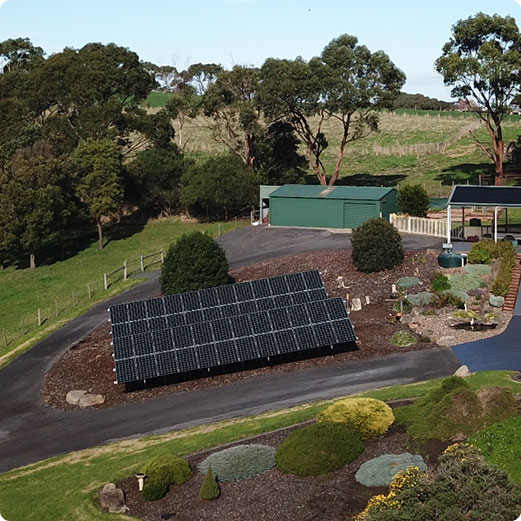Off-Grid Energy
Your experts in off-grid solar
Tindo Solar is already widely known as Australia’s only solar panel manufacturer, but did you know we can help you achieve total energy independence, too? Typical on-grid (or grid-connected) solar systems include solar panels and an inverter at the base level. You can also add battery storage and remain connected to the primary grid as a backup. But Tindo’s off-grid energy solutions allow you to completely break free from the national grid and never receive a power bill again.
Contact UsWhat are off-grid solar systems?
Off-grid solar systems work on a very similar principle as their on-grid counterparts. Consider a standard residential solar installation with solar panels and an inverter. It is your essential on-grid solar, where your panels power your home during daylight hours, and you switch back to the national grid at all other times. Some on-grid systems also feature battery storage yet maintain a connection to the national grid. The issue with this setup is that you may pay a series of fees or daily charges to your electricity retailer, regardless of whether you use electricity from the primary grid.
On the other hand, off-grid solar systems are entirely free from the primary grid. They use solar panels, an inverter, solar batteries and a backup generator for emergencies, and off-grid energy is now more attainable than ever. Solar panels power your home in daylight hours, and your battery takes care of your energy needs for all other times. If your solar batteries aren’t charged or run out of power, your backup generator is always there to fall back on.

The benefits of off-grid solar
You would consider handling your energy needs completely off-grid for a few major reasons. Let’s look at the main benefits of off-grid solar systems.
- Save money
Power your home with free energy from the sun. With no national grid connection, you’ll never pay for electricity again—off-grid solar slash your power bills by 100%. - Better for the environment
Unfortunately, we still use fossil fuels to supply power to the national grid. These outdated energy types are bad for the environment, but if you go completely solar, you reduce your carbon footprint considerably. - Reliable power
The national energy network constantly experiences outages through planned upgrades, weather events and other network faults. Since the sun never goes out, your batteries can constantly be recharged, and you won’t experience blackouts.
Naturally, there is an upfront cost for installing an off-grid solar system, but in time, the savings you make by eradicating your electricity bills cover this cost.
Components of an off-grid solar system
There are four main components to a typical off-grid solar connection.
- Solar panels
Tindo solar panels are made from premium materials and manufactured in Australia. Tested for Australian conditions, solar panels from Tindo are durable and reliable. They primarily harness the sun’s rays and produce direct current (DC) energy. - Inverter (or micro-inverters)
The inverter’s job is to take the DC energy from your solar panels and convert it into AC energy. AC is the type of energy that powers your home. Your inverter also sends excess solar energy to your battery storage. - Solar batteries
The number of solar batteries you need in an off-grid solar system depends on your consumption. We offer a range of solar battery storage options to suit your needs. In simple terms, the battery stores excess solar energy for use when the sun stops shining. - Generator
While not essential, most people who don’t maintain a connection to the national energy grid prefer to have a generator on standby in case they run out of solar power or experience an issue with their system.
How does an off-grid solar system work?
This is a simple step-by-step guide to how your off-grid solar system works.
- Solar panels collect energy from the sun’s rays.
- Your inverter converts solar (DC) energy into usable AC energy that powers your home.
- Unused solar energy charges your solar batteries.
- When the sun goes down, your charged solar batteries power your home.
- If you run out of solar energy, your generator takes over.
With the right off-grid solar system setup, you can ensure that your solar panels generate more than enough energy to power your home and fill your batteries. Our experts analyse your usual energy needs to recommend the perfect combination of solar panels and battery storage solutions to ensure you always have a reliable source of power.
Energy independence without going off-grid
If you’re concerned about not having the backup of the national grid but still want to achieve energy independence, Tindo Solar can help you there, too.
We can assess your energy needs and recommend the perfect combination of solar panels and solar batteries to power your home 24/7. However, you can remain connected to the national grid as a last resort. You can instantly draw from the primary grid in the unlikely event that you run out of solar. With this system, you would still have to pay your electricity retailer for any costs associated with being connected to the grid, even if you don’t use it.
This option may suit customers who want a certain level of self-sufficiency combined with energy savings but don’t want to use generators as a backup.
